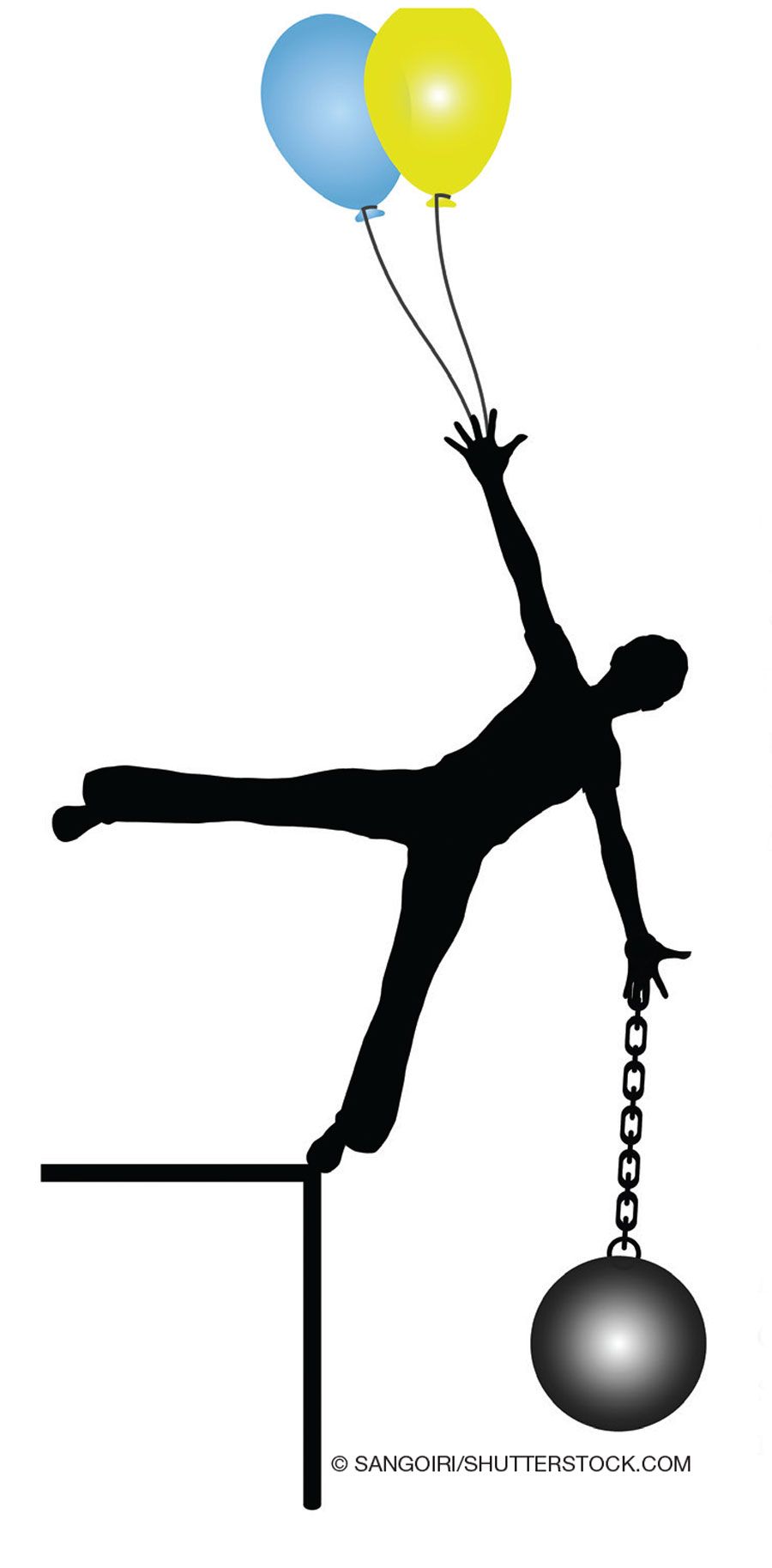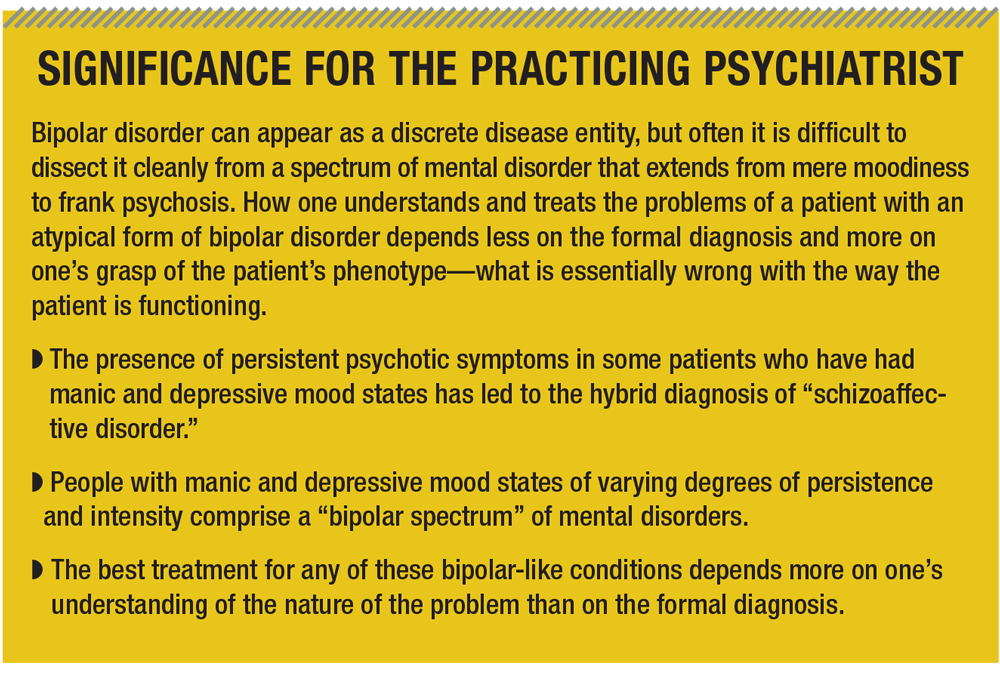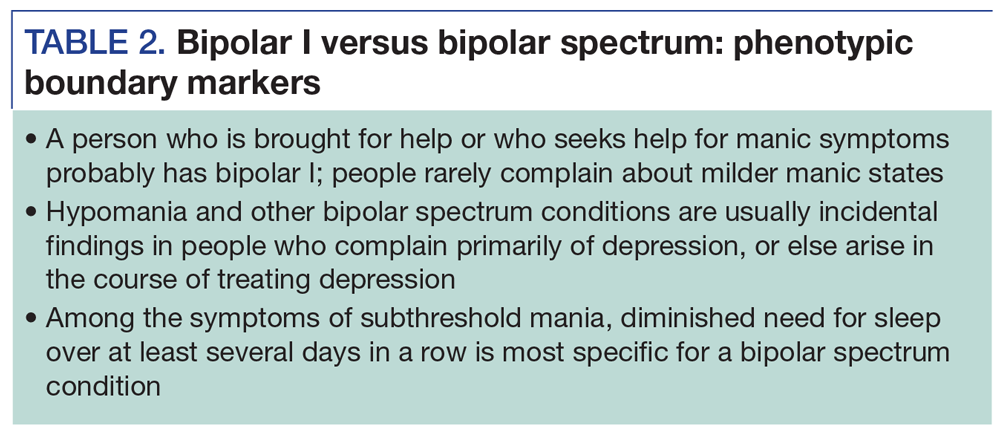Publication
Article
Psychiatric Times
The “Hard” and “Soft” Phenotypic Boundaries of Bipolar Disorder
Author(s):
There is no substitute for understanding one’s patient as an individual, and treating accordingly, keeping in mind the possibility that not all psychosis is schizophrenia and that moodiness may or may not indicate a place in the bipolar spectrum.
© Sangoiri/shutterstock.com

TABLE 1. Bipolar disorder vs schizophrenia: phenotypic boundary markers

SIGNIFICANCE FOR THE PRACTICING PSYCHIATRIST

TABLE 2. Bipolar I versus bipolar spectrum: phenotypic boundary markers

The bipolar disorder phenotype is as stable as any in psychiatry, and yet it floats uneasily between psychosis on one side and neurosis on the other. But why talk of “phenotype” rather than “diagnosis”? In psychiatry, diagnostic boundaries are mapped by consensus and fenced off by the criteria published in DSM. Arguing about them is as pointless as arguing about the rules of tennis-one might dispute a particular call, but the rules of the game are there in plain black and white.
The diagnostic rules of psychiatry provide a place for every patient, even when the patient’s symptoms do not cleanly meet criteria for any one diagnosis, for reasons “not otherwise specified.” But such ambiguous diagnoses provide no empirical or rational basis to understand or treat a problem. When in doubt, the clinical thinker asks: what is essentially wrong with the way the patient is functioning? The term “phenotype,” with its genetic connotations, implies a focus on the essence of the problem rather than its diagnostic rules.
In theory, phenotypic boundaries, unlike diagnostic boundaries, arise from some putative difference in the biological make-up of the phenomenon in question. The NIMH shifted in this direction when it instituted the Research Domain Criteria (RDoC) for phenotype definition, in lieu of conventional diagnoses, as a way to link psychopathology more explicitly to a structural or functional mechanism that will ultimately (it is hoped) be useful to ground our diagnoses in biology.1
Bipolar disorder vs schizophrenia
Let us consider the 2 principal borders of the bipolar phenotype: the “hard” distinction of bipolar vs schizophrenia on one side, and the “softer” division between bipolar disorder and other manifestations of mania and mood cycling-the bipolar spectrum-on the other.
CASE VIGNETTE
Curt is a 50-year-old, never-married, psychiatrically disabled outpatient referred by a departing colleague in the clinic. He has been in treatment since his mid-20s for a variety of conditions variously diagnosed as major depression, bipolar disorder, schizophrenia, and “psychosis NOS.” Until 10 years ago, he worked in a family business: since then he has only been successful at holding occasional part-time jobs.
He had his “first break” during his freshman year of college, and has been hospitalized on several occasions since for episodes alternately of severe paranoia and agitation and of suicidal depression. When agitated, he believes the Pentagon is after him because he has designed an earthquake machine that could be harnessed as a weapon of war. When depressed, he is so racked by guilt over his machine that he feels the world would be better off if he died and took his secret with him. After struggling for many years to find and remain on effective treatment, over the past decade he has remained stable, albeit functioning marginally, on the same combination of lithium and an atypical neuroleptic.
During the visit, Curt states that he is doing “OK” and has no complaints about his mood, or particular fears about being in danger. He bristles a little when asked about his invention and says ominously “it’s best if I don’t talk about it.” He is relatively content with his medication regimen so no changes are made in his prescriptions, and he is sent for routine labs. Unfortunately, the next day his creatinine comes back 0.5 points higher than before, and so it appears he will probably have to stop lithium to spare his kidneys.
The new psychiatrist wonders whether Curt’s stability over the past decade is due to the lithium or to the neuroleptic medication-or both. If his illness is really a chronic psychotic bipolar or schizoaffective disorder, removing lithium might trigger a new round of paranoia and suicidality. But if his delusions are really just a manifestation of schizophrenia, then discontinuing lithium might not affect his mental illness.
Emil Kraepelin’s century-old rules for differentiating bipolar disorder and schizophrenia are still more or less operative today: episodic abnormal affective states define the former, chronic psychotic states define the latter.2 For cases when both are present, psychiatry has invented the term “schizoaffective disorder.”
Old-style family, twin, and adoption studies supported the distinction between bipolar disorder and schizophrenia.3 However, with the growing recognition that both disorders have complex causes, and the advent of genome-wide scans across thousands of individuals, the boundary between them is not so hard after all.4,5 Findings indicate what some had suspected all along-that there may well be some genetic factors shared by people who have bipolar disorder and schizophrenia.6
The practical question is simpler than the genetic question. A clinician who treats a person who clearly has both mood swings and psychosis should consider prescribing a neuroleptic along with a mood-stabilizing agent like lithium or an antiepileptic agent. Once mood swings and psychosis are under control, the clinical dilemma hinges on whether and when to stop medications, which in turn depends on the phenotype (Table 1).
Schizophrenia or schizoaffective diagnoses likely entail long-term neuroleptic use and on psychosocial intervention to ensure stable functioning in the community. Bipolar disorder with psychosis suggests that mood stabilization will be as important as neuroleptics in quelling the psychotic symptoms and restoring functioning.
Bipolar I vs bipolar II and the bipolar spectrum
The softer boundary between bipolar and bipolar spectrum disorders is less easily discerned than the (until recently) hard boundary between bipolar disorder and schizophrenia. Kraepelin, when describing variants of the abnormal moods he observed in his manic depressive patients, noted “a lack of all sharp boundaries” between the milder mood swings of cyclothymia and severe affective disorder. We might call cyclothymia and a variety of other mood-related maladies the components of a spectrum of manifestations of bipolar disorder.7
CASE VIGNETTE
Ethel, a 29-year-old divorced IT specialist, has been referred by her primary care clinician with the complaint, “The antidepressant quit on me.” Her family history is notable for a wayward father who once moved the family to New Zealand, then lapsed into a months-long torpor. Ethel had a brief, impulsive marriage immediately after college, then settled into a corporate job that went well for several years until her increasingly explosive temper led to an abrupt dismissal. She soon had a “nervous breakdown” that lasted several months, during which it took great force of will just to get out of bed to shower.
She finally reached out to her gynecologist, who prescribed an SSRI. Within days she was feeling better than ever, and had more than enough energy to hit the street to find another IT job. Her quick wit, sparkling personality, and infectious confidence were so impressive that her present employer hired her on the spot. She still felt well after her SSRI prescription ran out, and did not refill it.
She was less sparkly but generally well for several more years until last year when, once again, her motivation evaporated. Her primary care clinician prescribed an antidepressant, which gave her a period of high energy, confidence, and initiative; then she crashed into lethargy. She tried a different antidepressant with similarly dramatic high, then low results. She then agreed to see the psychiatrist to find out why her depression was so resistant to treatment.
The psychiatrist suggests she might have an atypical form of bipolar disorder, exacerbated by antidepressants. She is reluctant to give up the antidepressant because she still feels depressed, but does agree to add lithium. In the following months she continues to cycle between low and near-normal, no highs, switching every few weeks. She is eventually persuaded to stop the antidepressant and to stick with lithium alone, and she settles into a more stable mood over the next 6 months.
Patients in the bipolar spectrum present with mood cycling and/or sub-syndromal manic symptoms, along with clinically significant depressive symptoms.9 A broad list of bipolar spectrum presentations includes:
• Recurrent unipolar MDD
• Bipolar II: major depressive episodes with mild manic states (hypomania)
• Manic mood swings only while taking antidepressants or stimulants
• Cycling into and out of depression without reaching hypomania
• Cyclothymia (moody without full-severity manias or depressions)
• Hyperthymic personality at baseline but lapsing into depression
• Ultra-rapid and ultradian cycling-moods that fluctuate from day to day or hour to hour
• Borderline personality disorder-with “affective instability”
These distinctive patterns might suggest real differences in phenotype, or merely variations on the theme of mood cycling. The problem is that the broader bipolar spectrum proves difficult to study, in part because of diminishing diagnostic reliability as one gets further away from classic bipolar I, leading some to doubt whether these forms of moodiness are properly understood as expressions of the same disorder.8
Genetic studies reveal that some expressions of the bipolar spectrum are related to bipolar I disorder. Bipolar II disorder is the most common bipolar phenotype in many families.9 There tend to be many depressed relatives of people with bipolar disorder, but not so much bipolar disorder among relatives of people with only depression.
Beyond the diagnostic reliability problem with bipolar spectrum disorders, there is the practical problem that mood swings below the acuity of mania fail to arouse complaints.10 Someone like Ethel might downplay mild manias because they are nothing like what Dad went through. Clinicians must probe for periods of elation, excitement, irritability, and restlessness combined with a diminished need for sleep and an increase in speech and activity, and then convince the patient that any hints of these may be important diagnostically even if they don’t seem to be a clinical problem on their own (Table 2).
Frequent cycles of 2 months or less-with or without hypomania-make antidepressants useless. With such frequent cycles, one cannot tell a true antidepressant response from a spontaneous remission. A careful history of symptom evolution before and after antidepressant therapy can be the key to whether antidepressants are making the patient more unstable. Add lithium, other anticonvulsant “mood stabilizers,” or atypical neuroleptics when treating patients with possible bipolar spectrum depressions. Consider withdrawing antidepressants altogether. Mood charting is essential. Documenting daily mood ratings may be the only way to avoid recall bias, and to notice trends that unfold over many months, as this sort of affective fine-tuning tends to do.
Conclusion
We psychiatrists live in a world where clinical diagnosis is the gold standard, but our diagnostic rules are derived from consensus, not science. We may or may not ever gain the power to differentiate one person’s disorder from another’s based on objective laboratory findings. There is no substitute for understanding one’s patient as an individual, and treating accordingly, keeping in mind the possibility that not all psychosis is schizophrenia and that moodiness may or may not indicate a place in the bipolar spectrum.
Disclosures:
Dr. MacKinnon is Associate Professor, Department of Psychiatry and Behavioral Science, Johns Hopkins University School of Medicine, Baltimore, MD. He is the author of Trouble in Mind: An Unorthodox Introduction to Psychiatry and Still Down: What to Do When Antidepressants Fail. He reports no conflicts of interest concerning the subject matter of this article.
References:
1. Insel TR. The NIMH Research Domain Criteria (RDoC) Project: precision medicine for psychiatry. Am J Psychiatry. 2014;171:395-397.
2. Kraepelin E, Robertson GM (transl). Manic Depressive Insanity and Paranoia. Salem, NH: Ayer Company; 1921.
3. Smoller JW, Finn CT. Family, twin, and adoption studies of bipolar disorder. Am J Med Genet. 2003; 123C:48-58.
4. Cardno AG, Owen MJ. Genetic relationships between schizophrenia, bipolar disorder, and schizoaffective disorder. Schizophr Bull. 2014;40:504-515.
5. Schulze TG, Akula N, Breuer R, et al. Molecular genetic overlap in bipolar disorder, schizophrenia, and major depressive disorder. World J Biol Psychiatry. 2014;15:200-208.
6. Crow TJ. The continuum of psychosis and its genetic origins: the sixty-fifth Maudsley lecture. Br J Psychiatry. 1990;156:788-797.
7. Hirschfeld RM. Bipolar spectrum disorder: improving its recognition and diagnosis. J Clin Psych. 2001;62(suppl 14):5-9.
8. Slavney PR. Affective disorder: the new imperium. Comp Psychiatry. 1991;32:295-302.
9. Simpson SG, Folstein SE, Meyers DA, et al. Bipolar II: the most common bipolar phenotype? Am J Psychiatry. 1993;150:901-903.
10. Cassano GB, Dell’Osso L, Frank E, et al. The bipolar spectrum: a clinical reality in search of diagnostic criteria and an assessment methodology. J Affect Disord. 1999;54:319-328.






